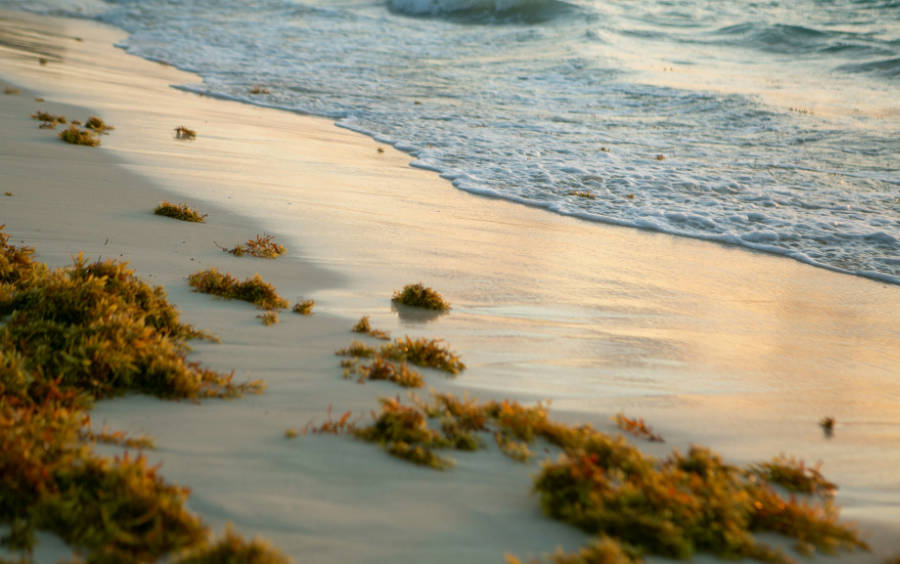
Sargassum in 2025: Riviera Maya Faces a Severe Crisis
It has been bad in previous years, but sargassum in 2025 has had one of its worst seasons so far.
Before the sun rises over the Caribbean, beach cleanup crews are already at work across the Riviera Maya. In Tulum, Playa del Carmen, and Puerto Morelos, locals meet the morning tide with rakes and shovels, confronting a stubborn intruder: waves of drifting sargassum. These seaweed invasions have become more than just an inconvenience—they’re a daily ritual of resistance that shapes life along the coast.
In 2025, this recurring environmental threat has returned with record intensity. From the busy tourist beaches of Playa del Carmen to the quieter shores of Puerto Morelos, every community is feeling the impact. Once considered seasonal, the sargassum problem has now become a permanent concern that challenges both the environment and the economy of Mexico’s Caribbean coast.
Sargassum Season 2025: The Challenge Intensifies
In 2025, sargassum is back with full force. This year’s arrival has pushed communities from Cancún to Tulum to their limits. Over a decade ago, the first massive seaweed blooms hit the Mexican Caribbean. Since then, the region has adapted to the rhythm of this invasive algae.
But 2025 is different. Forecasts warned early of a record bloom. Satellites spotted an enormous sargassum belt forming in the Atlantic, six times larger than in past years. By January, scientists predicted one of the most intense seasons ever recorded.
The calm of January and February gave false hope. But by March, over 320 tonnes of sargassum were removed in Tulum. April brought 300 more, and May hasn’t slowed down. In Playa del Carmen, crews cleared 200 tonnes per day.
Why Is There So Much Sargassum?
The cause lies in a mix of rising sea temperatures, excess nutrients, and shifting currents. The return of La Niña in 2025 has fueled growth. In December 2024, satellites saw 75% more algae than usual. By spring, levels were double any previous April.
Environmental Damage Along the Coast
Floating in the ocean, sargassum supports marine life. Onshore, it’s a different story. Decomposing seaweed creates hypoxic conditions, killing fish and stressing coral reefs. Its smell—caused by hydrogen sulfide—impacts local air quality.
For nesting turtles, the challenges are greater. Many eggs are buried, and hatchlings struggle to reach the ocean. Beach erosion worsens with heavy machinery. Cleaning efforts risk damaging fragile dunes and aquifers.
Tourism and Livelihoods Are at Risk
Tourism drives the Riviera Maya’s economy. When beaches are covered in seaweed, bookings drop. Restaurants, dive shops, and taxis all feel the impact. Fishermen struggle as their nets fill with algae, and their engines clog.
As one hotel manager in Playa del Carmen said, “It’s not just an eyesore—it’s hundreds of jobs.”

Cleanup Efforts Across the Riviera Maya
This year, the response has been stronger and faster. The Mexican Navy collects seaweed offshore. Floating barriers help redirect it. In Tulum, cleanup crews have nearly doubled. Hotels now start work before sunrise to protect their beaches.
Still, disposal remains difficult. Drying and storing the seaweed safely takes time and space. Volunteers, school groups, and NGOs continue to support daily cleanup and awareness efforts.
How 2025 Compares to Past Seasons
2018 and 2019 were severe, but 2023 saw 13 million tonnes in the Atlantic—then the worst year. El Niño made 2024 mild. But 2025 changed everything. Ocean warming and unchecked runoff fueled a massive new bloom.
Yet there’s progress. Authorities now work together better. New technology and stronger protocols are in place. Each past year has built stronger infrastructure—and stronger communities.
Turning a Crisis Into Opportunity
Across the region, people are finding new uses for sargassum. Researchers are turning it into fertilizer, packaging, biofuel, and even construction materials. Some experiments explore carbon capture by sinking dried seaweed into the ocean.
Children now learn about sargassum in school. Locals share tips on how to cope and care for dunes. One researcher called it “a visible sign of a deeper imbalance,” but also a call to action.
A Region Rising Together
Tulum and the Riviera Maya face a tough summer. But with collaboration, innovation, and community spirit, they continue to fight back. As the seaweed rolls in, so does determination.
We invite you to join the conversation. Share your stories, ideas, and solutions with us on social media. Help shape a more resilient future for the coast we all love.
Source: Tulum Times

